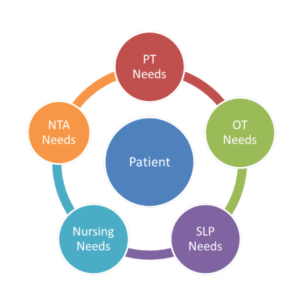Final rule cuts deep
The long-term care industry is now facing an 11.1 percent Medicare payment reduction to SNFs for 2012 in new rates to be implemented October 1.
The Centers for Medicare & Medicaid Services (CMS) on July 29 announced a final rule reducing SNF payments by $3.87 billion, or 11.1 per-cent lower than payments for FY 2011. The new rates, CMS said, correct for an unintended spike in payment levels “and better align Medicare payments with costs.”
In mid-July, as Congress and President Obama argued over deficit reduction and debt limit options, industry leaders, nurses and administrators converged on Capitol Hill hoping to reverse-or at least modify-the cuts announced by CMS.
The reduction is needed, CMS said, to account for a forecasting error regarding utilization of services, which resulted in overpayments to many facilities. CMS had considered a second option reflecting the standard rate update methodology that would have provided a net 1.5 percent increase. Thus, the industry considers the total reduction imposed to be 12.6 percent.
“We’re here to defend the quality of care that our residents deserve,” said Mark Parkinson, president and CEO of the American Health Care Association/National Center for Assisted Living (AHCA/NCAL) during the march on Capitol Hill. “This is about preserving and improving the quality of life of those people who need it most.”
The National Association for the Support of Long Term Care (NASL), LeadingAge and the Alliance for Quality Nursing Home Care (Alliance) also sought to inform lawmakers of the impact of the proposed reductions on member companies and their patients and asked lawmakers for help. The groups opposed slashes in Medicare and Medicaid as part of proposed deficit reduction plans.
“The proposed rule could impose significant cuts in payments to SNFs, restrict access to group therapy services and saddle clinicians with new reporting burdens,” NASL said in a memo to members regarding the Congressional “fly-in.” “In addition to the detrimental clinical provisions, the proposed rule would force health IT vendors to adapt these changes without giving them adequate preparation time.”
LeadingAge President and CEO Larry Minnix issued a statement before the announced payment reduction detailing responses of non-profit nursing home members who anticipated the proposed Medicare cuts would be “devastating.” “The reductions in Medicare funding our members anticipate as a result of the proposed rule range from $200,000 to almost $500,000,” Minnix said last month. “According to MedPAC’s latest report, nursing homes already have aggregate payment margins-‘all payers, all lines of business’-of 3.5 percent. MedPAC found that one-quarter of nursing homes had total margins at or below minus 1.2 percent. Clearly, Medicare payment cuts that would average 11 percent and that could range up to 20 percent or more would be unsustainable for organizations already straining to provide high-quality care with ever-shrinking resources.”
“We pride ourselves on the level of quality care given in our ministry by the dedicated staff that walks our halls,” one LeadingAge member said. “The reduction in revenue would force us to reduce our staffing levels and cut back on many expenses-ultimately affecting the quality of care…. Trying to solve the debt crisis problem by eliminating life preserving care for seniors cannot be the right answer.”
“Impact of 11.3 [sic] percent cut is $356,000,” said another member. “This is on top of an Ohio Medicaid cut of $275,000. Any more and we send the government the keys.”
“We urge CMS, policymakers on Capitol Hill, and the Obama administration to do what is right,” said Minnix. “We look to CMS to reconsider proposed changes in Medicare payments that are based on flawed calculations and that would penalize most heavily those nursing homes that currently care for the most medically complex residents.”
Meanwhile, the Alliance urged CMS to “prospectively recalibrate payment corrections…in a manner that does not disrupt facilities’ continued ability to offer quality care to the nation’s Medicare beneficiaries.”
“The Alliance acknowledges payment problems resulting from the transition to the new RUGs-IV system and is committed to working with Congress and CMS to correct this,” said Alan G. Rosenbloom, the organization’s president.
CMS determines its SNF payments using a case-mix classification system known as Resource Utilization Groups (RUG). Each RUG-IV group is assigned a case-mix index that reflects relative differences in patient acuity. It is intended to reflect the kind of services a person requires, according to medical need and intensity of treatment. According to CMS, new SNF patients are now being classified into one of the highest paying therapy groups more than 40 percent of the time, compared to less than 10 percent as originally projected, which resulted in the overpayments.
“SNFs cannot withstand over-correction because of the fragile economics of the sector driven primarily from substantial under-reimbursement by the Medicaid program,” Rosenbloom said, noting that the estimated shortfall in Medicaid payments was projected last year to be $17.33 per resident per day.
“Given the uncertainty regarding the actual level of overpayments, prospective corrections must be made in a gradual manner based on additional experience,” he explained, noting that the proposed changes by CMS were based on only three months of data. “CMS’ proposed option to implement a net reduction of 11.3 percent for SNF payment rates in FY 2012 would adversely affect an already fragile sector and would be inconsistent with the manner in which corrections have been implemented in other sectors,” Rosenbloom declared.
“We look to CMS to reconsider proposed changes in Medicare payments that are based on flawed calculations and that would penalize most heavily those nursing homes that currently care for the most medically complex residents.”
Bob Gatty has covered governmental developments for the trade and business press for more than 30 years. He is founder and president of G-Net Strategic Communications, Sykesville, Md. Long-Term Living 2011 August;60(8):14-15

Robert Gatty has more than 40 years of experience in journalism, politics and business communications and is the founder and president of G-Net Strategic Communications based in Myrtle Beach, South Carolina. He can be reached at bob@gattyedits.com.
Related Articles
Topics: Articles , Medicare/Medicaid











